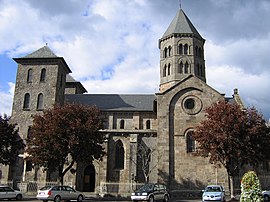|
Mauriac, Cantal
Mauriac (French pronunciation: [moʁjak] ⓘ; Occitan: [mawɾiˈak]) is a commune in the Cantal department in the Auvergne region in south-central France. It lies 63 kilometres (39 mi) north-northwest of Aurillac by rail. Mauriac, built on the slope of a volcanic hill, has a medieval church, and the buildings of an old abbey now used as public offices and dwellings; the town owes its origin to the abbey, which originated from a 6th-century foundation. GeographyMauriac is situated in the northwest of Cantal, close to the border with the Corrèze and Limousin departments. The greater part of the Mauriac arrondissement is watered by the Saint-Jean, a brook which flows past the southwestern edge of the town and fills the lac du Val Saint-Jean, a small reservoir, before flowing into Auze, an important tributary of the Dordogne. Mauriac is in hilly terrain, with the main populated area falling into a zone at an altitude of about 350–450 metres, while the surrounding areas rise to about 760 metres in the volcanic foothills. HistoryChildebert, daughter of Clovis I, reported that she had had a vision of the Virgin Mary, carrying the infant Christ, and accompanied by Saint Peter. This led her to found a chapel at the side of the Rieu Mauri, the small stream now known as the ruisseau Saint-Jean. This later grew into the Benedictine abbey of Saint Peter, the centre of a considerable pilgrimage. Increasing wealth allowed the abbey to begin construction of a considerable Romanesque church in the 11th century, commencing with the choir. The nave and belfry followed in the 12th century, and the process culminated in the building of a great west portal, surmounted by an Ascension of Christ, in the 13th. The belfry fell into disrepair during the French Wars of Religion and during the French Revolution, requiring reconstruction in 1625 and in 1845. The two towers were 17th century additions. The abbey itself was dissolved during the Revolution and the land sold off in lots. The remains of the abbey buildings were incorporated into houses and municipal buildings. A large part of these remains, including the chapter house, were purchased by the town in 1984 and restored with the help of the Ministry of Culture. The town became notable during the Revolutionary period for the work of Catherine Jarrige (1754–1836), a tertiary of the Dominican Order, famous both for her works of charity. She was especially noted for concealing refractory priests, who refused to compromise with state control of the Church, as embodied in Civil Constitution of the Clergy of 1790. She remains closely associated with the church and was beatified by Pope John Paul II in 1996. The church, now known as Notre-Dame-des-Miracles, was promoted to the status of basilica in 1921, under Pope Benedict XV, and is now one of 167 churches so recognised in France. It remains a place of pilgrimage, and its fine furnishings and fittings attract considerable interest. AdministrationMauriac is the seat of a sub-prefect and has a tribunal of first instance and a communal college. The present mayor is a member of the centre-right Union for a Popular Movement. PopulationInhabitant of the area are known as Mauriacois in French.
Culture and languageThe Mauriac area is a stronghold of the Auvergnat dialect of the Occitan language, which has about 1.5 million speakers, mostly in the Puy-de-Dôme and Cantal départements. Although all of the population also speak French, Auvergnat is still the mother tongue in many homes and is still used in public and in private by some residents. Its lexis, grammar and phonology are also likely to influence the usage of spoken French. The placename Mauriac has precisely the same written form in both languages but is pronounced as "Mouria" in Auvergnat. EconomyMauriac is the main market town and shopping centre of the arrondissement. It still attracts pilgrims, as well as tourists because of its proximity to the Dordogne valley and the mountains of Cantal, particularly the Puy Mary. The countryside of Mauriac and its neighbouring communes is known as the Pays de Salers, and is marketed under this name. It is famous for its dairy industry, particularly Salers and Cantal cheeses. There are marble quarries in the vicinity of Mauriac. Major buildingsMauriac has a considerable number of medieval and early modern buildings, mostly grouped in its historic centre, close to the basilica church and the former abbey site. Together, they form the main focus for tourists in the town. Romanesque basilica of Notre-Dame-des-MiraclesA fine building in a local Auvergnat version of the Romanesque style. It is noted particularly for its carved western portal and its collection of 18th century Baroque furnishings. Remains of Saint Peter's abbeyThe abbey was built in the 12th century to replace an earlier Carolingian monastery, which had itself been built on the site of a pagan shrine dedicated to Mercury. The most important remains, including the chapter house, are now in municipal ownership. Former Jesuit collegeBuilt after 1563 under the terms of a bequest of Guillaume Duprat, bishop of Clermont, and rebuilt in the 18th century, the college has a magnificent portal and a Baroque chapel with a prominent retable. Today the building serves the local lycée. Hôtel d'OrcetBuilt in the 18th century by Gabriel de Viger d'Orcet, a local tax collector, and incorporating a restored 15th-century tower, the hôtel houses two large Aubusson tapestries representing outdoor games. Today it is the headquarters of the sub-prefecture. Notable people
See alsoReferences
Gallery
External linksWikimedia Commons has media related to Mauriac (Cantal). |
||||||||||||||||||||||||||||||||||||||||||||||||||||||||||||||||||||||||||||










